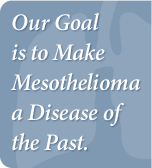ASBESTOS HISTORY
This archive provides an introduction to asbestos history and then presents a collection of news articles and references categorized by era, i.e. 1950s, 1960s, 1970s, etc. Hyper links are provided to help you jump to the era and section of history of your particular interest. This is provided by our research team as part of their continuous effort to discovery new medical advancements in the field of mesothelioma cancer cure. These archive postings demonstrate the slow process of social and political awareness to the dangers of exposure to asbestos, and the manner in which the public has responded. The Mesothelioma Research Foundation of America is very concerned that public awareness of asbestos exposure as well as the risk of getting mesothelioma cancer from exposure is still not great enough to deliver the needed level of support and funding to produce a cure for this disease.
Introduction to Asbestos History
Asbestos History - Present Era 2000's
Introduction
Asbestos is a mineral that is made up of silicon, oxygen, hydrogen and other metal ions. These needle shaped fibers are so small that they cannot be seen unless the concentration in the air is very heavy. Asbestos is an excellent material for insulation because the fibers are strong, flexible and will not burn. The three most common forms of asbestos fibers are chrysolite, amosite and crocidolite. Because asbestos is such a tiny fiber, it needs to be attached to something. When asbestos fibers are mixed with other materials, it produces what is called an asbestos containing material.
Many industrial products are made of asbestos, including thermal insulation (pipe, block & cement); fireproofing acoustical texture products; textile and cloth products (asbestos gloves, blanket, etc.); spackling, patching & taping compounds; gaskets and packing, asbestos-cement pipe and sheet material, ceiling tiles, wall board, siding and roofing; friction materials (brakes & clutches). Asbestos materials had been used by the automotive industry, shipping industry and NASA for insulating the Space Shuttle.
The dust that is created from the manufacture, installation and eventual deterioration of asbestos materials releases asbestos in the air. Asbestos becomes a health hazard only when these materials crumble, fall apart, are damaged or ripped. When asbestos materials are damaged, fibers are released into the air, where they may stay suspended for long periods of time. Asbestos can then be inhaled and the fibers can lodge deeply in the lungs.
The Federal government placed a moratorium on the production of most asbestos products in the early 1970's, but these products continued to be installed through the late 1970's and even into the early 1980's. Asbestos cement pipe which would need to be cut, beveled, and grinded by pipe fitters had continued well into the late 1980s and sometimes the 1990s.
Commercial production of asbestos insulation began in 1879, and the first case of asbestos-related disease, described as "curious bodies" in the lungs was detected in 1899. The first cases of asbestosis and lung cancer attributable to asbestos exposure were diagnosed in the United States in 1935. The Congressional Library of Congress has had a book on the harmful effects of asbestos and its link to cancer causation as it discusses the analysis of work place illnesses on its shelves since it was published in 1939.
Most health information on asbestos has been derived from studies of workers who have been exposed to asbestos in the course of their occupation. Asbestos fiber concentrations for these workers were many times higher than those encountered by the general public. Although the risks associated with low-level non-occupational exposure are not as well established, the Environmental Protection Agency (EPA) concludes that there is no safe level of exposure to asbestos fibers.
History Era: 1950s
Uniform Labeling Program for Hazardous Materials
Department of the Navy
By Office of the Secretary
Washington 25, D. C.
September 24, 1956
During the 1950's manufacturers and the United States Government were becoming aware of chemicals and materials that were dangerous when exposed to people during usage. This letter from Office of the Secretary at the Department of the Navy demonstrates their awareness and response.
Chronology of Asbestos Cancer Discoveries:
Experimental Studies of the Saranac Laboratory
Commentary
By Gerrit W.H. Schepers, MD, SCD
American Journal of Industrial Medicine 27:593-606
(1995)
This commentary reviews the research of Dr. Le Roy Upson Gardner conducted in 1942 that inhaled chrysotile fibers could induce malignant neoplasia in mice; and between 1951 and 1954, using cancer-insusceptible mice, yielded neoplasia risk ratio of 5.7 compared with control animals. The studies also showed that the primary effect of chrysotile is to cause epithelial proliferation in alveoli adjacent to bronchioles. Gardner had written letters and reports designating some of the mouse tumors as malignant and he attributed the tumors to inhaled chrysotile asbestos fibers, even though the mice had not developed asbestosis. Gardner had found in 1942 that the majority of the mouse tumors were truly malignant. Details are provided in a manuscript on the "Thirty Years of Asbestos Research of the Saranac Laboratory between the years 1928 and 1958" by Gerrit Schepers. These details are fairly clearly recorded in Dr. Gardner's handwritten notes (cited in the book noted above) because he did not publish these research findings in technical journals, for his work was performed on behalf of industrial sponsors, from whom he did not have permission to publish.
History Era: 1970s
Brake lining dust linked to cancer
Asbestos blamed
By JEAN PEARSON
News Science Writer
24-C--THE DETROIT NEWS Thursday, July 27, 1972
Asbestos in automobile brake linings may be a potential cause of cancer, a Wayne State University School of Medicine research team fears. Dr. Andrew Reeves, chief of the research team, said yesterday that overexposure to asbestos particles is known to be the cause of a number of lung diseases, including cancer. But what isn't known, he said, is whether use of the brakes releases harmful particles into the air.
ASBESTOS is used in brake linings, building materials and, to some extent, in the clothing industry. In addition to lung cancer, overexposure to asbestos may lead to asbestosis, a degenerative type of lung disease, and possibly to mesothelioma, a tumor of the lining of the chest cavity, or pleura.
Dr. Reeves said the asbestos industry denies, on good evidence, that asbestos released into the air from automobile brakes poses a health hazard because the high temperatures incurred in braking mean the asbestos has taken another form. "But the final word is not known," Dr. Reeves said, nothing that is not known yet what that form is and whether it presents any hazard to humans.
Seeking "the final word," Dr. Reeves and his research team are planning an experimental system that will simulate the mechanical action of brakes, heat the asbestos to 1,500 degrees Fahrenheit and blow the dust into chambers for inhalation by guinea pigs. The guinea pigs will then be
History Era: 1990s
A Cohort study of mortality among wives of workers in the asbestos cement industry
Casale Monferrato, Italy
By CORRADO MAGNANI, BENEDETTO TERRACINI, CHRISTIANA IVALDI, MARIO BOTTA, PAOLA BUDEL, ANGELO MANCINI, ROBERT ZANETTI
British Journal of Industrial Medicine 1993; 50:779-784
The study investigates mortality from cancer and other diseases in a cohort of wives of asbestos cement workers in Casale Monferrato (northern Italy). The cohort comprised of 1,964 women after the exclusion of those with an occupational record in the asbestos cement industry. A woman's domestic exposure to asbestos was estimated according to their husbands' periods of employment in the asbestos plant. The occurrence of malignant mesotheliomas after domestic exposure to asbestos has been shown. Despite the well known association between asbestos and malignancies and the suggestions from case reports and case-control studies of mesotheliomas due to domestic exposure to asbestos only one cohort study has been published so far on mortality among family contacts of asbestos workers. In this study, except for pleural neoplasms, mortality among women with the opportunity for exposure to domestic asbestos was not statistically different from that expected for any of the causes of death considered.
All women reported to have a pleural cancer and all but two of those dying from lung cancer had been exposed for at least 10 years. In conclusion this study found a clear excess of mesotheliomas among wives of workers in the asbestos cement production industry. Our results are in agreement with the only similar study published before and confirm the importance of avoiding contamination of asbestos workers' homes.
History Present Era: 2000s
WASHINTON
EPA declares asbestos health emergency in Montana town
By MATTHEW DALY
Associated Press
THE SACRAMENTO BEE Thursday, June 18, 2009
WASHINGTON -- The Obama administration said Wednesday it will pump more than $130 million into a Montana town where asbestos contamination has been blamed for more than 200 deaths.
Environmental Protection Agency Administrator Lisa Jackson said the EPA for the first time has determined there is a public health emergency in a contaminated community, targeting Libby, Montana for immediate federal attention.
Jackson's announcement will not result in an evacuation of Libby's 2,600 residents but will require an extensive, home-by-home cleanup and better health protections for those with asbestos-related illnesses.
NATION
EPA tackles town's deadly dust
By NICHOLAS K. GERANIOS
Associated Press
THE SACRAMENTO BEE Thursday, June 18, 2009
LIBBY, Mont. -- Yvonne Resch remembers thinking as a child that the vermiculite mine only added to the area's natural beauty -- its lights on Zonolite Mountain looked like a castle.
But the mine and its processing plants spewed asbestos over her town for more than 70 years, coating homes, schools and ball fields. Now her father, mother and two brothers are among many residents who suffer the coughing, hacking and wheezing of asbestos-related diseases, which have been blamed in more than 200 deaths since the late 1990s.
The Environmental Protection Agency took the unprecedented step this week of declaring Libby a federal public health emergency, vowing to finish a cleanup that has languished for nearly a decade.
The agency pledged at least $125 million to speed the work of going door-to-door, raising tents over contaminated homes, removing contaminated soil and vacuuming out attics and any other surface once contaminated by miners returning from work.
NATION
Asbestos sales thrive in developing countries
LOBBY GROUPS SPEND MILLIONS TO KEEP TRADE GOING
By JIM MORRIS
International Consortium of Investigative Journalists
THE SACRAMENTO BEE
WASHINGTON -- A global network of lobby groups has spent nearly $100 million since the mid-1980s to preserve the international market for asbestos, a known carcinogen that's taken millions of lives and is banned or restricted in 52 countries, the International Consortium of Investigative Journalists has found in a nine-month investigation.
Backed by public and private money and aided by scientists and friendly governments, the groups helped facilitate the sale of 2.2 million tons of asbestos last year, mostly in developing nations.



For questions related to the foundation and to make contributions please contact:
Executive Director
Toll Free:
(800) 909-Meso (6376)
3011 Townsgate Rd, Suite 450
Westlake Village, CA 91361
For more information and other questions contact:
(800) 909-6376
©2024 Mesothelioma Research Foundation Of America
